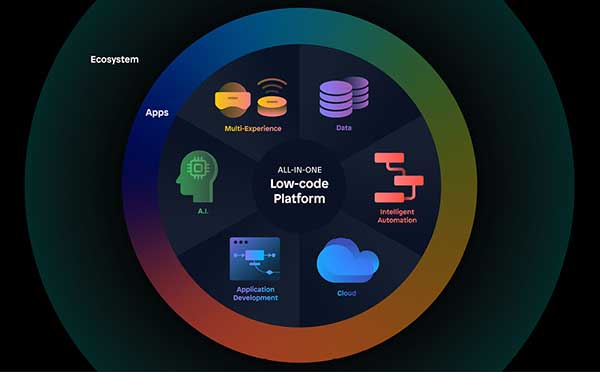Recommended Ideas On Choosing Low-Code Platform Examples
Recommended Ideas On Choosing Low-Code Platform Examples
Blog Article
The Benefits Of Low-Code Development For Developing Applications As It Relates To Integration Capabilities
Low-code development is a great method to create applications that seamlessly integrate with various platforms and services. Here are the benefits of pre-built APIs and connectors:
A Wide Range of Connectors : Low-code platforms usually come with a large library of pre-built connectors to the most popular enterprise software (e.g. ERP, CRM, databases, and cloud services). The process of integration is simplified.
API Integration: Many low code platforms come with integrated APIs that are built-in that let developers connect easily with external services and sources of data.
Easy To Use
Drag-and–Drop Integration: Integrations can be set up by using drag and drop interfaces. Both developers and non-developers can accomplish this without having to write lengthy code.
Visual Workflow builders: These visual tools are designed to create workflows, data flows, and integrations. They assist in understanding and establishing them more easily.
Standardized Integration Methods:
SOAP and restful services: Supporting web service standard protocols such as REST and SOAP makes integration easy with many different platforms and systems.
OData Standards: OData standards allow for the easy manipulation and retrieval of data across different platforms and applications.
Real-Time Data Synchronization:
Real-Time Integrations: Low-code platforms can handle the real-time synchronization between data applications, systems as well as databases. This will ensure that all data is current and consistent across an organisation.
Event-Driven Architecture: Some platforms support event-driven architectures, enabling applications to respond to events in real-time. This is vital for interactive and dynamic applications.
Legacy System Integration:
Low-code Platforms: These can be used to connect older systems to the latest. They are a great way to upgrade your IT infrastructure, without having to redesign everything.
Data Migration Tools - Built in data-migration tools make it easy to move data from old systems to applications that use low-code.
Third-Party Service Integration:
Cloud Services Integration: Easy deployment and scaling applications is possible with seamless integration with cloud services such as AWS, Azure and Google Cloud.
Business Application Integration: Low-code platforms have the ability to connect to various business applications, such as Salesforce, SAP, Microsoft Dynamics, etc. This allows for a seamless workflow across different business functions.
Simplified Data Processing
Unified Data Models: Some low-code platforms offer unification of data models, which simplify the management of data and integrate across various systems.
Data Connectors: These pre-configured data connectors permit easy access to and manipulation of data derived from different sources.
Security and Compliance:
Low-code platforms ensure that integrations comply with security protocols and standards and safeguarding data while it is in transit and while it is in its rest.
The platforms come with features that guarantee integrations meet regulatory requirements (e.g. GDPR, HIPAA), giving those who manage sensitive data security.
Extensibility:
Low-code platforms permit the addition of custom scripts and codes to satisfy more complicated integration requirements. This flexibility is available without compromising user-friendliness.
Plug-in Ecosystems. A network of extensions and plug-ins allows you to further enhance the capabilities of integration, while adding new functionalities whenever needed.
Low-code platforms can be a useful device to build interconnected, effective and scalable applications. They streamline the process of connecting disparate systems, improve data flow, and enable companies to make use of existing technology while embracing new ones, thus ensuring an integrated and cohesive IT environment. Have a look at the top rated Low-code Platform for application development for more advice including app dev platform, push alerts, develop cross platform mobile app, cross platform app development, app development platform, azure sql databases, mobile app development platforms, rad development, build with docker, cross platform app dev and more.
Advantages Of Low-Code Application Development In Terms Of Flexibility And Scale
Low-code applications offer a variety of benefits, especially in terms scalability. It is crucial to develop applications that develop with your business and adapt to grows. Here are a few of the main advantages.
Cloud-based deployment: A lot of lowcode platforms run on the cloud, which enables applications to grow with the infrastructure. This enables businesses to manage increased loads without worrying about the management of servers.
Auto-Scaling feature: Built-in features that automatically scale resources in order to accommodate demand and ensure constant performance, even without manual input in peak hours.
Flexible Architecture:
Modular design: Low-code platforms are a great way to promote modular applications. This allows components to be developed independently and tested, scaled and so on. Modularity increases flexibility, and it is easier to modify specific elements of an app without having to affect the entire system.
Microservices integration: The ability to support microservices architecture lets applications be built as a collection of loosely coupled services. This increases capacity and flexibility.
Customizable Solutions:
Extensibility Low-code systems typically allow for custom-written code and scripting. This lets developers extend applications' functionality beyond what is available out of the box. This guarantees that specific requirements of business can be met without constraints.
Third-Party Integrations: The capability to connect with third-party services and APIs allows businesses to incorporate additional functionalities and services when needed to enhance the functionality of the application.
Agile Development and Deployment
Continuous Delivery and Deployment Low-code Platforms support agile methodologies through enabling continuous integration and Continuous Delivery (CI/CD). This allows applications to be updated and upgraded quickly as a result of user feedback.
Iterative Development - The low-code model lets applications be enhanced and scaled up incrementally which reduces risk and allows for a more controlled expansion.
Resource Optimization
Efficient Resource Management: Low-code platforms allow you to maximize the use of resources by offering tools for monitoring and managing application performance. This helps ensure that resources are utilized effectively. They can also be scaled-up or down depending on the needs of the user.
Load-balancing features that distribute workloads equally among servers increase the ability of an application to handle large volumes of traffic and ensure consistent performance.
Global Reach:
Multi-Region deployment: Low-code applications are often able to support deployment across different geographical regions. This enables businesses to offer low-latency to users around the world. This is essential for applications that serve an international audience.
Localization Support. The built-in ability to localize applications allows them to be easily adjusted to various languages, regional requirements and increases their flexibility across various markets.
Maintenance and Updates:
Simple Maintenance : Low-code apps' visual and modular nature simplifies maintenance tasks. This allows the release of updates and bug fixes to be completed quickly and without long periods of downtime.
Version Control: Integrated version control system helps control changes and roll backs. This ensures that updates can be easily implemented and earlier versions restored if required.
Cost Efficiency:
Low Development Costs. Through reducing the code requirements, low-code platforms lower the development cost and enable applications to be scaled up without increasing development effort.
Pay-As You-Go Models: Many low-code platforms offer flexible pricing models, like pay-as-you-go, which align costs to actual usage and growth, allowing financial flexibility.
Overall, low-code app development provides businesses with the flexibility and scalability they require to create robust and adaptable applications. These platforms enable quick adjustments to changing demands, efficient resource use, and constant improvement, which ensures that applications develop and grow in line with business needs. Take a look at the most popular Enterprise application development with Low-code Platform for more tips including cross platform mobile dev, azure sql databases, lowcode no code, cross platform app development, stored sql procedures, develop cross platform mobile app, rad application development, no code platforms, ms azure sql, ms azure sql and more.
The Benefits Of Low-Code Development To Collaborate And Streamline Workflow
Low-code development has many advantages in collaboration and workflow. This makes it a great option for companies looking to boost productivity and simplify the development process. Here are the top advantages: Improved Collaboration Across Functions:
Unified Development Environment: Low-code platforms offer a unified, single environment where team members comprising business analysts, developers designers, and stakeholders can work efficiently. This eliminates silos, as well as improves communication.
Visual Development The platform's visual drag-and-drop features make it easy for nontechnical team participants to contribute to the design process. It also ensures that business requirements are accurately gathered and implemented.
Communication Improved:
Real-Time Collaboration: A lot of low-code platforms have real-time collaboration features, such as the simultaneous editing of comments, and instant feedback, which facilitate continuous communication and reduce the time spent on back-and-forth discussions.
Workspaces shared by teams can to work in tandem on shared workspaces in which they modify and discuss project components. This helps ensure that everyone is working towards the same goals and is on the same page.
A streamlined workflow management system:
Project management tools that are built-in Low-code platforms typically come with integrated project management tools that allow teams to plan, track and oversee their projects. This includes task management, progress tracking and management of deadlines.
Workflow Automation - Automating repetitive tasks or workflows allows teams to concentrate their energy on more strategic projects and activities, improving the overall efficiency of the organization.
Speedier iteration cycles:
Rapid Prototyping: Low-code platforms allow quick prototyping and iterative development, allowing teams to develop, test, and refine applications over shorter periods of time. This allows feedback to be quickly incorporated, and improvements can be implemented.
Support for agile development: Using agile practices allow teams to work continuously in sprints. This allows them to adapt and deliver small steps to improve functionality.
Accessibility for Non-Developers:
Citizen Development - Low-code platforms offer business users the ability to develop and modify applications without coding expertise. This reduces the burden on IT and development teams and allows for quicker response to the business demands.
Training and Onboarding. The intuitive interfaces of training tools make it easy for the new members to be familiar with the system. this improves collaboration.
Centralized Documentation and Knowledge Sharing
Documentation integrated Low-code features typically permit you to create and manage documents within the platform. The entire project's information will be centralized and easily accessible.
Knowledge Repositories Teams can create and maintain repositories of information that contain best practices templates, templates, and other reusable elements, facilitating sharing of knowledge and reducing duplicate work.
Consistency & Standardization
Standardized components: Standardized components, built in advance, ensures consistency in the applications. Team members can comprehend and work better on various parts.
Governance and Compliance: Built-in governance structures ensure that every development follows organizational standards and regulatory requirements, reducing the risk of non-compliance and ensuring that applications meet high-quality standards.
Feedback and Improvement:
Integrated Feedback Platforms with Low-Code provide users with feedback mechanisms integrated into them that enable them to provide easy feedback on applications. Feedback from users can used in the development process.
Continuous Improvement: The capacity of rapidly implementing changes based upon feedback ensures that applications are constantly improved, aligning closely with the requirements and goals of the users.
Visualization and Reporting:
Real-Time Analytics: Built-in analytics and reporting tools provide real-time insights into project progress, performance and user interaction, enabling data-driven decision-making.
Visual Workflow Analysis: Visual tools are used to visualize workflows and processes. These tools aid teams to analyze and improve their workflows.
Low-code development of applications is a powerful tool for collaboration and workflow. It connects disparate teams, streamlines communication, and automates processes. This creates a flexible, collaborative, and efficient developing environment that produces higher-quality apps.